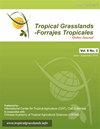A maceration treatment of leucaena foliage improves its nutritional value by reducing mimosine concentration
IF 0.7
4区 农林科学
Q3 AGRICULTURE, DAIRY & ANIMAL SCIENCE
引用次数: 0
Abstract
Giant leucaena produces high dry matter yields but the foliage contains mimosine, a non-protein amino acid that is toxic to animals, especially non-ruminants. Reducing mimosine concentration in foliage following harvesting may allow for greater use of Giant leucaena and mitigate the negative aspects of higher mimosine concentration in some varieties. We evaluated two methods for post-harvest treatment of foliage of a highly productive interspecific hybrid variety ‘KX2’ for reducing mimosine concentration: (i) maceration treatment; and (ii) extraction with 0.1 N HCl. Mimosine as a percentage of leaf dry matter ranged from less than 1% DM to around 3% DM. Although both methods reduced mimosine concentration, extraction by 0.1 N HCl also reduced gross energy, protein and carbohydrate concentrations of leucaena foliage. The maceration treatment, on the other hand, caused little reduction in crude protein and crude fat concentrations but markedly increased the carbohydrate concentration. ADF and NDF concentrations were also reduced as a result of maceration treatment. The estimated gross energy concentration in macerated foliage was not significantly lower than in unprocessed foliage. A suitable mechanical method for post-harvest maceration of leucaena foliage, e.g. a wood-chipping machine, could be used to reduce mimosine concentration in the foliage, making it safer for feeding to livestock and enhancing the feed value, especially for non-ruminants. These methods should be tested by conducting feeding studies to determine the possible benefits in animal performance from feeding macerated foliage.白叶浸渍处理通过降低含羞草苷浓度提高其营养价值
大白星的干物质产量很高,但叶子中含有含羞氨酸,这是一种对动物,尤其是非反刍动物有毒的非蛋白质氨基酸。收获后降低叶中含羞草苷的浓度可能有助于更多地使用大白星,并减轻某些品种含羞草素浓度较高的负面影响。我们评估了高产种间杂交品种“KX2”采后处理叶片以降低含羞草苷浓度的两种方法:(i)浸渍处理;和(ii)用0.1N HCl萃取。含羞草素在叶片干物质中的百分比范围从小于1%DM到大约3%DM。尽管这两种方法都降低了含羞草苷的浓度,但用0.1N HCl提取也降低了亮氨酸叶片的总能量、蛋白质和碳水化合物浓度。另一方面,浸渍处理导致粗蛋白质和粗脂肪浓度几乎没有降低,但碳水化合物浓度显著增加。ADF和NDF浓度也由于浸渍处理而降低。经浸渍的树叶中估计的总能量浓度并不显著低于未经处理的树叶。可以使用一种合适的机械方法,如木屑切割机,在收获后对亮氨酸叶进行浸渍,以降低叶中含羞草苷的浓度,使其更安全地饲养牲畜,并提高饲料价值,尤其是对非反刍动物。这些方法应通过进行喂养研究来测试,以确定喂养浸渍树叶对动物性能的可能益处。
本文章由计算机程序翻译,如有差异,请以英文原文为准。
求助全文
约1分钟内获得全文
求助全文
来源期刊

Tropical Grasslands-Forrajes Tropicales
Agricultural and Biological Sciences-Agronomy and Crop Science
CiteScore
1.60
自引率
0.00%
发文量
36
审稿时长
16 weeks
期刊介绍:
The Journal publishes, in English or Spanish, Research Papers and Short Communications on research and development, as well as contributions from practitioners (Farmer Contributions) and Review Articles, related to pastures and forages in the tropics and subtropics. There is no regional focus; the information published should be of interest to a wide readership, encomprising researchers, academics, students, technicians, development workers and farmers.
In general, the focus of the Journal is more on sown (''improved'') pastures and forages than on rangeland-specific aspects of natural grasslands, but exceptions are possible (e.g. when a submission is relevant for a particularly broad readership in the pasture and forage science community).
The Journal will also consider the occasional publication of associated, but closely related, research in the form of an additional scientific communication platform [e.g. a re-make of the former Genetic Resources Communication series of the former Division of Tropical Crops and Pastures of the Commonwealth Scientific and Industrial Research Organisation (CSIRO), Australia].
Areas of particular interest to the Journal are:
Forage Genetic Resources and Livestock Production[...]
Environmental Functions of Forages[...]
Socio-economic Aspects[...]
Topics within the aforementioned areas may include: Diversity evaluation; Agronomy; Establishment (including fertilization); Management and utilization; Animal production; Nutritive value; Biotic stresses (pests and diseases, weeds); Abiotic stresses (soil fertility, water, temperature); Genetics and breeding; Biogeography and germplasm collections; Seed production; Ecology; Physiology; Rhizobiology (including BNF, BNI, mycorrhizae); Forage conservation; Economics; Multilocational experimentation; Modelling.
 求助内容:
求助内容: 应助结果提醒方式:
应助结果提醒方式:


